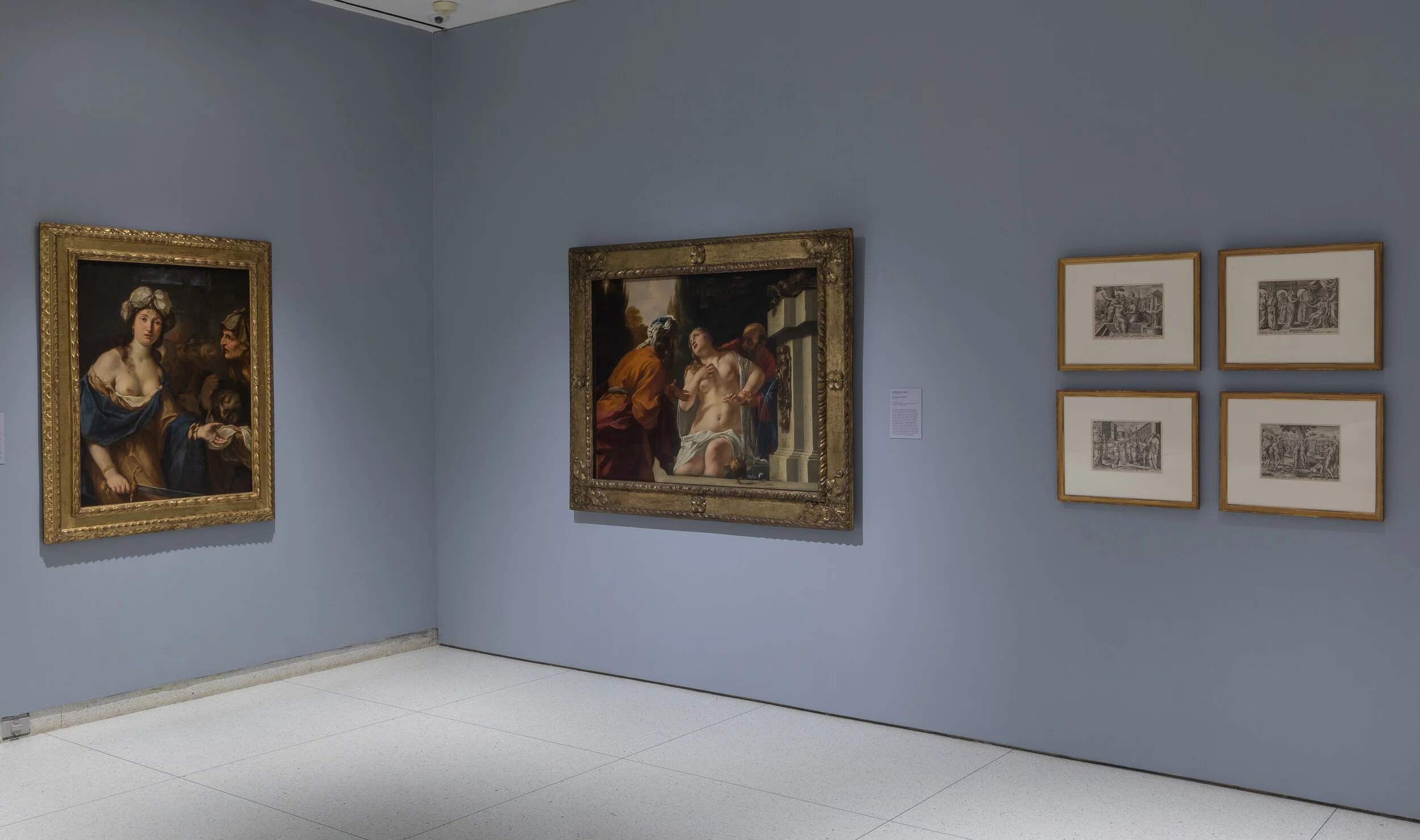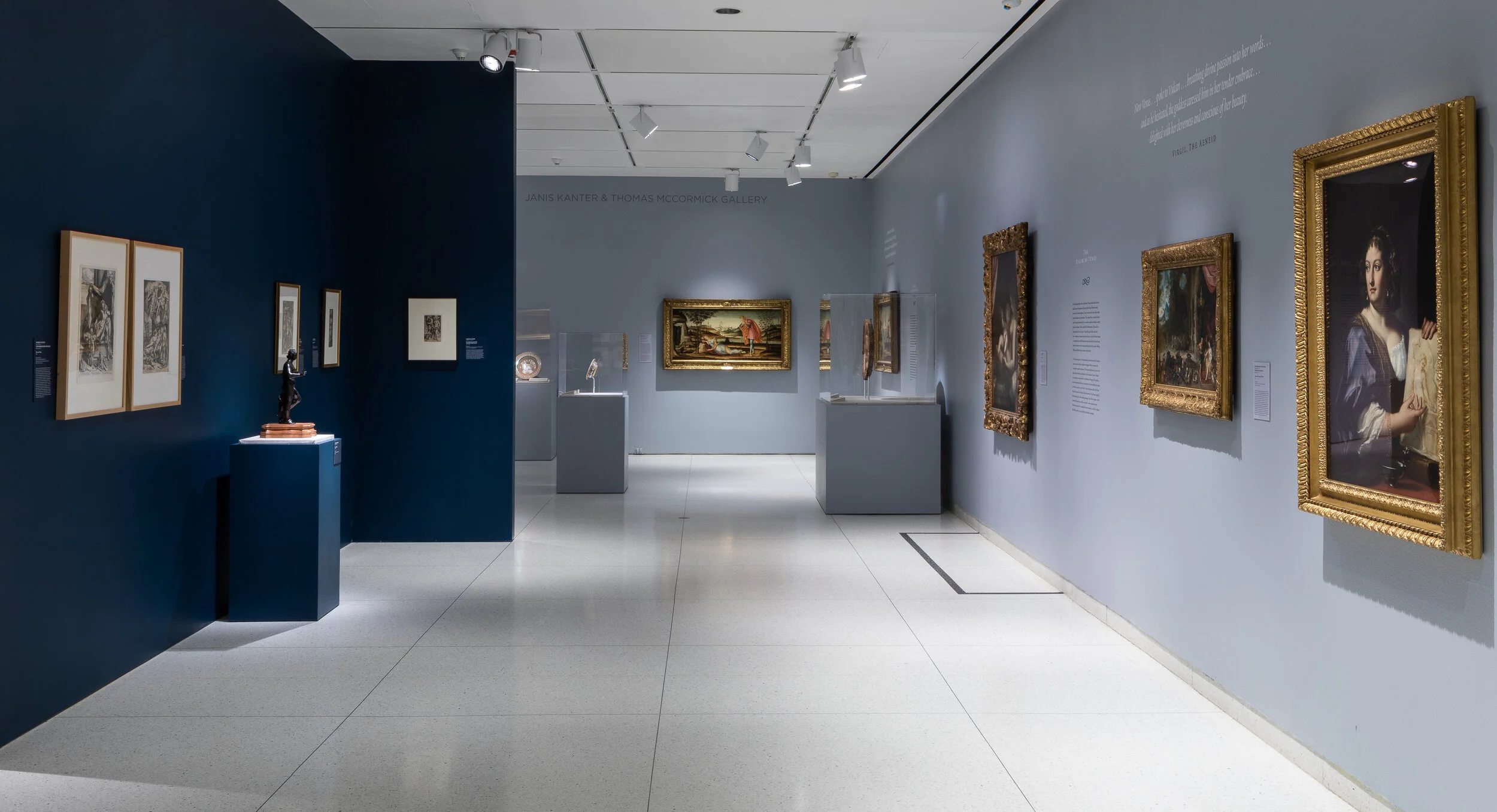A World Indoors: Lust, Love, and Loss at the Smart Museum
By Ellen Wiese
The first show at the Smart Museum dedicated to the art of the early modern period in over a decade, Lust, Love, and Loss in Renaissance Europe examines the role and implications of domestic art created between 1400 and 1700. In this exhibition, organized by the Feitler Center for Academic Inquiry, Andrew W. Mellon Curatorial Fellow Nora S. Lambert set out to reframe whose stories matter to art historical conversations.
“Generations of scholars had determined which objects merit attention and which did not, deciding to study the ‘important’ artworks: the large altarpieces, the grand fresco cycles, all the monumental commissions. Very few had any interest in looking at something that women passed around at home.”
“A lot of the categories that we apply to Renaissance art, the hierarchies that we give to them, are much later impositions,” says Lambert. “Generations of scholars had determined which objects merit attention and which did not, deciding to study the ‘important’ artworks: the large altarpieces, the grand fresco cycles, all the monumental commissions. Very few had any interest in looking at something that women passed around at home.”
In many ways, the entire discipline of art history is built around the monumental work of the Renaissance, says Niall Atkinson, Chair and Associate Professor of Art History and author of The Noisy Renaissance: Sound, Architecture, and Florentine Urban Life. The famous art of this period, Atkinson says, “has become naturalized in our understanding of what Western art is, what beauty is…And a lot of that work is actually making beautiful what are various sorts of problematic relationships that are social, economic, and gendered.” Now, scholars including Lambert are increasingly making use of the extensive archives of the time to shift focus to the people and works that traditional scholarly discourse has ignored. “It’s about trying to understand this culture’s contradictions,” says Atkinson. “These stories have been told, for other kinds of meaning, across the bodies of women.”
“Lust, Love, and Loss in Renaissance Europe, installation view at the Smart Museum of Art, The University of Chicago, 2021. Photo by Michael Tropea.
Investigating the oft-ignored setting of artwork in the home, as Lambert and her peers are doing, allows scholars and historians to examine how Renaissance women interacted with their world and challenge the dominant narrative of art history. “We’ve inherited so much directly from this period,” says Atkinson. “It’s important to understand why these things either do matter, or why they don’t matter. Are they constructed, and can we change them?” Under Lambert’s direction, the exhibition represents the complex relationships between passion, violence, and virtue in order to recontextualize whose stories are told, what art is deemed significant, and how art history is defined in the field of the Renaissance and beyond.
The Path to Lust, Love, and Loss
A little more than ten years ago, Lambert attended an exhibition at the Metropolitan Museum of Art called Art and Love in Renaissance Italy. This exhibition was part of a somewhat recent movement that called for the reexamination of traditionally ignored domestic art, and, for Lambert, it raised the initial questions that would eventually lead to Lust, Love, and Loss. Instead of considering more traditional, monumental material—like public altarpieces by famous painters, for example—Lambert says, “I wanted to know how works of art might speak equally to concerns of everyday life, how they might also have something to do with contemporary social mores and cultural norms and ideals, rather than continue to maintain this dichotomy of ‘domestic art’ and ‘high art.’”
“Lust, Love, and Loss in Renaissance Europe, installation view at the Smart Museum of Art, The University of Chicago, 2021. Photo by Michael Tropea.
Lambert, now a PhD Candidate in Art History at The University of Chicago, did not always intend to study the art of late medieval and early modern Italy. Inspired by global relocations during her childhood, she initially went to school for international relations—before realizing in her first class that she had no interest in the subject. During her subsequent quarter-life crisis, she encountered a friend’s Italian Renaissance art textbook. “I was transfixed,” Lambert says. “I thought, ‘I have no idea what this is, but I’ll study it for the next four years.’” Luckily, her campus had an excellent art museum and object-based art history curriculum. And due to the museum’s small staff, she was able to get in on the ground floor: two weeks after she decided to major in art history, she began working at the museum. After graduation, Lambert continued her work at museums including the Mount Holyoke College Art Museum, the Art Institute of Chicago, and the Philadelphia Museum of Art. In 2020, she was selected for the Center of Curatorial Leadership and Mellon Foundation Seminar in Curatorial Practice—one of fourteen graduate students nationwide.
In addition to the usual spate of challenges that come with pulling together an exhibition, COVID-19 threw a toolbox worth of wrenches into the works. The opening was initially scheduled for September of 2020; when the pandemic forced the Smart to close in March, Lambert worried that the entire exhibition would be cancelled. In the end, it was postponed twice: first to January 2021, and then again to April. With 42 objects, Lust, Love, and Loss draws on local and national museum collections, and the rescheduling meant that the Smart had to change the dates on their lenders twice, “each time lighting candles and praying that the lenders would be amenable,” says Lambert. When one institution pulled out, Lambert went on a nationwide quest to locate the key prints elsewhere, culminating in an eleventh-hour rescue from the Middlebury College Museum of Art. Through it all, the collaboration and assistance of colleagues at the Feitler Center and the Smart and at art museums across the country was key. From locating prints to coordinating gallery design remotely, says Lambert, “everybody was pitching in.”
Lust, Love, and Loss at the Smart Museum
The 300-year span covered by the exhibition, now on display in the Smart’s galleries, was a period marked by intellectual, social, political, and religious upheaval. A crisis of demographics caused by successive waves of plagues had led to an emphasis on the values of motherhood and conception; accordingly, domestic art often commemorated momentous events like marriage and childbirth. These works lay at the heart of cultural rituals and were intended to simultaneously entertain and instruct.
The exhibition begins with commemoration in “At Home in the Renaissance,” as Lambert surrounds the viewer with the objects that would have once surrounded Renaissance families in their homes, marking rites of passage like betrothals, marriages, and births. For Renaissance women in particular, who were largely confined to the domestic sphere, these objects represented the establishment of a controlled universe that exemplified a woman’s identity and good taste. From here, the exhibition takes us into “The Realm of Venus,” highlighting the pagan goddess as a source of instruction as well as artistic and aesthetic inspiration. Lambert then shifts into “Paragons of Virtue,” highlighting historical, mythological, and biblical women whose bodies acted as metaphorical sites for the enacting of cultural conflicts and values. The exhibition aptly concludes with the role and influence of death in “Morality and Mortality,” examining complex attitudes towards death through the skeletal figure that lurks in the background of the art and consciousness of the time.
“Lust, Love, and Loss in Renaissance Europe, installation view at the Smart Museum of Art, The University of Chicago, 2021. Photo by Michael Tropea.
“The things that people have in their houses, the images they have, are really their way of relating to the outside world.”
By focusing on familial and domestic artworks, Lambert wanted to pull apart the dichotomy that modern audiences often impose between art that is “moralizing and prescriptive” and that which is “entertaining and pleasing.” Renaissance viewers were well-versed in media that spoke to societal ideals while maintaining a sense of wit and humor. To take one example, two spalliere, or wall panels, from the Smart Museum’s collection depict the god Apollo coming upon a sleeping Daphne. This story plays upon a common trope of the time in which men stumble upon women sound asleep in the forest and are instantly transfixed by their beauty—“I suspect that read just about as humorously ludicrous then as it does now,” says Lambert. At the same time, the spalliere stress the importance of chastity, patriarchal protection, and proper matches. Regardless of the wit or artistry in the presentation, “there were very real social consequences for women and for men, were they to act outside of proper societal constraints,” says Lambert. “This fictionalized violence, these fictionalized romances, were the means by which they dealt with very pressing questions.”
A World Indoors
The timing of Lust, Love, and Loss during a global pandemic lends its own significance to the period covered in the exhibition. Lambert focuses on works that would be found in the domestic sphere; likewise, audiences over the past year have largely been confined to their homes. “We surround ourselves with things that give us our sense of who we are, what we stand for, what we’re interested in,” says Lambert. “The things that people have in their houses, the images they have, are really their way of relating to the outside world.” Lust, Love, and Loss in Renaissance Europe is an exhibition uniquely suited to our time of chaos and transition—an opportunity for some to see art in person for the first time in more than a year, and to consider these objects’ personal and scholarly impact with new understanding.
“Lust, Love, and Loss in Renaissance Europe” is on display at the Smart Museum until June 13, 2021. To plan your visit, find out more about exhibition programming, and enjoy a virtual tour, visit smartmuseum.uchicago.edu/exhibitions/lust-love-and-loss-in-renaissance-europe. Reservations are available Thursday through Sunday on a timed basis.



